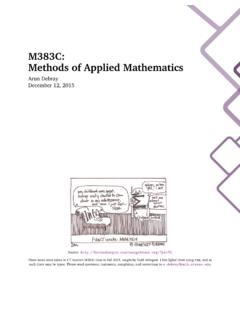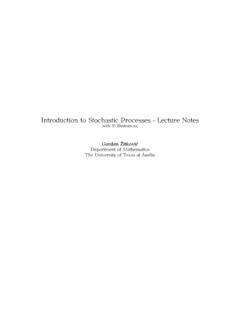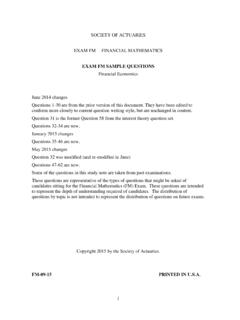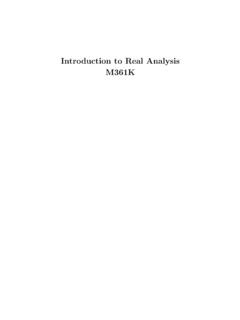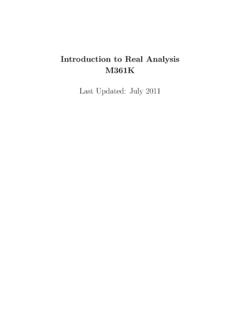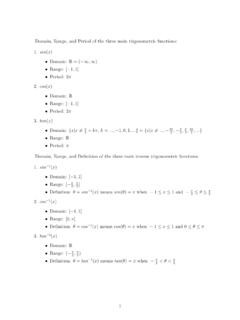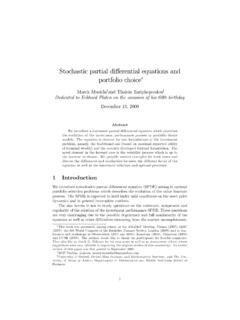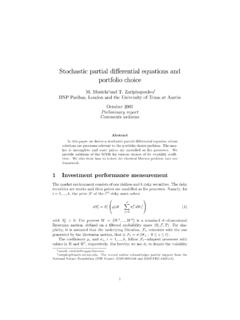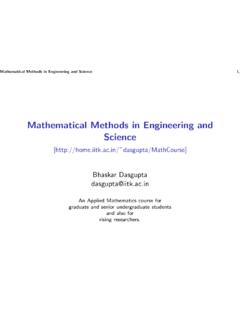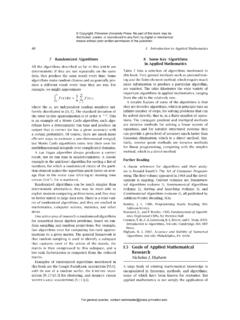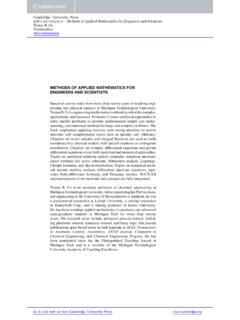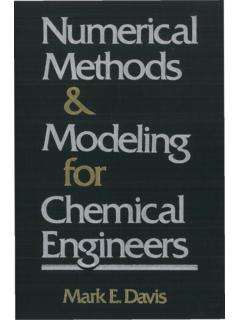Transcription of Methods of Applied Mathematics
1 Methods of Applied MathematicsTodd Arbogast and Jerry L. BonaDepartment of Mathematics , andInstitute for Computational Engineering and SciencesThe University of Texas at AustinCopyright 1999 2001, 2004 2005, 2007 2008 (corrected version)by T. Arbogast and J. 1. Elementary Lebesgue Measure and Exercises23 Chapter 2. Normed Linear Spaces and Banach Basic Concepts and Some Important Hahn-Banach Applications of The Embedding ofXinto its Double DualX The Open Mapping Uniform Boundedness Compactness and Weak Convergence in a The Dual of an Exercises66 Chapter 3.
2 Hilbert Basic Properties of Best Approximation and Orthogonal The Dual Orthonormal Weak Convergence in a Hilbert Exercises87 Chapter 4. Spectral Theory and Compact Definitions of the Resolvent and Basic Spectral Theory in Banach Compact Operators on a Banach Bounded Self-Adjoint Linear Operators on a Hilbert Compact Self-Adjoint Operators on a Hilbert The Ascoli-Arzel`a Sturm Liouville Exercises122 Chapter 5. The Notion of Generalized Test Operations with Convergence of Distributions and Approximations to the Some Applications to Linear Differential Local Structure ofD Exercises148 Chapter 6.
3 The Fourier TheL1(Rd) The Schwartz Space TheL2(Rd) TheS Some Exercises172 Chapter 7. Sobolev Definitions and Basic Extensions from The Sobolev Imbedding TheHsSobolev A Trace TheWs,p( ) Sobolev Exercises204 Chapter 8. Boundary Value Second Order Elliptic Partial Differential A Variational Problem and Minimization of The Closed Range Theorem and Operators Bounded The Lax-Milgram Application to Second Order Elliptic Galerkin Green s Exercises229 Chapter 9.
4 Differential Calculus in Banach Spaces and the Calculus of Fixed Points and Contractive Nonlinear Higher The Euler-Lagrange Constrained Extrema and Lagrange Lower Semi-Continuity and Existence of Exercises273 Bibliography279 CHAPTER 1 PreliminariesWe discuss in this Chapter some of the pertinent aspects of topology and measure theorythat are needed in the course of the rest of the book. We treat this material as background, andwell prepared students may wish to skip either of both Elementary TopologyIn Applied Mathematics , we are often faced with analyzing mathematical structures as theymight relate to real-world phenomena.
5 In applying Mathematics , real phenomena or objects areconceptualized as abstract mathematical objects. Collections of such objects are objects in a set of interest may also be related to each other; that is, there is somestructureon the set. We call such structured (1) A vector space (algebraic structure).(2) The set of integersZ(number theoretical structure or arithmetic structure).(3) The set of real numbersRor the set of complex numbersC(algebraic and topologicalstructure).We start the discussion of spaces by putting forward sets of points on which we can talk aboutthe notions ofconvergenceorlimitsand associatedcontinuityof simple example is a setXwith a notion of distance between any two points ofX.
6 Asequence{xn} n=1 Xconverges tox Xif the distance fromxntoxtends to 0 definition relies on the following formal functionon a set is a functiond:X X Rsatisfying:(1) (positivity) for anyx,y X,d(x,y) 0, andd(x,y) = 0 if and only ifx=y;(2) (symmetry) for anyx,y X,d(x,y) =d(y,x);(3) (triangle inequality) for anyx,y,z X,d(x,y) d(x,z) +d(z,y).Ametric space(X,d) is a setXtogether with an associated metricd:X X (Rd,| |) is a metric space, where forx,y Rd, the distance fromxtoyis|x y|={d i=1(xi yi)2}1 turns out that the notion of distance or metric is sometimes stronger than what actu-ally appears in practice.
7 The more fundamental concept upon which much of the mathematicsdeveloped here rests, is that of limits. That is, there are important spaces arising in appliedmathematics that have well defined notions of limits, but these limiting processes arenotcom-patible with any metric. We shall see such examples later; let it suffice for now to motivate aweaker definition of PRELIMINARIESA sequence of points{xn} n=1can be thought of as converging toxif every neighborhood ofxcontains all but finitely many of thexn, where a neighborhood is a subset of points containingxthat we think of as close tox.
8 Such a structure is called atopology. It is formalized space(X,T) is a nonempty setXof points with a familyTofsubsets, calledopen, with the properties:(1)X T, T;(2) If 1, 2 T, then 1 2 T;(3) If Tfor all in some index setI, then I familyTis called atopologyforX. GivenA X, we say thatAisclosedif its complementAc=X\A={x X:x6 A}is any nonempty set, we can always define the two topologies:(1)T1={ ,X}, called thetrivialtopology;(2)T2consisting of the collection of all subsets ofX, called sets andXare both open and closed. Any finite intersection ofopen sets is open.
9 Any intersection of closed sets is closed. The union of any finite number ofclosed sets is need only show the last two statements, as the first two follow directly from thedefinitions. LetA Xbe closed for I. Then one of deMorgan s laws gives that( IA )c= IAc is , ifJ Iis finite, the other deMorgan law gives( JA )c= JAc is open. It is often convenient to define a simpler collection of open sets that immediately generatesa a topological space (X,T) and anx X, abase for the topology atxis a collectionBxof open sets containingxsuch that for any openE3x, there isB Bxsuchthatx B E.
10 Abase for the topology,B, is a collection of open sets that contains a base atxfor allx collectionBof subsets ofXis a base for a topologyTif and only if(1)eachx Xis contained in someB Band(2)ifx B1 B2forB1,B2 B, then there issomeB3 Bsuch thatx B3 B1 B2. If(1)and(2)are valid, thenT={E X:Eis a union of subsets inB}.Proof.( ) SinceXandB1 B2are open, (1) and (2) follow from the definition of a baseatx.( ) LetTbe defined as above. Then T(the vacuous union),X Tby (1), andarbitrary unions of sets inTare again inT. It remains to show the intersection property.
